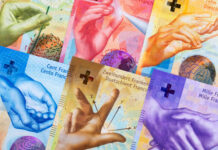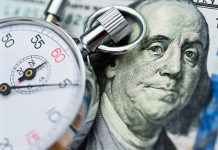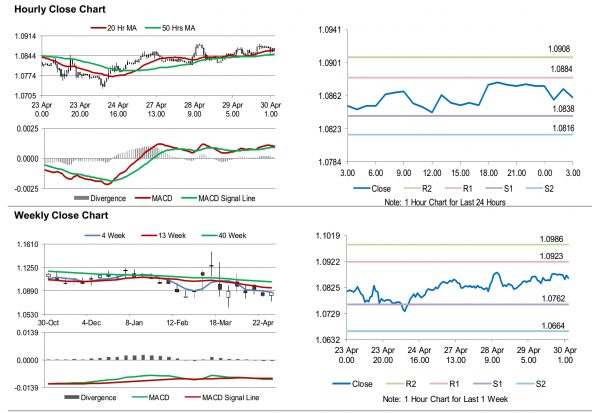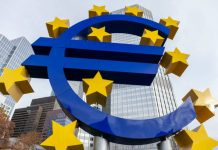For the 24 hours to 23:00 GMT, the EUR rose 0.44% against the USD and closed at 1.0874.
On the macro front, Euro-zone’s consumer confidence index eased to -22.7 in April, compared to a level of -11.6 in the previous month. The preliminary figures had indicated a drop to -22.7.
Additionally, the industrial confidence index plunged to -30.4 in April, more than market expectations for a fall to a level of -25.7. In the prior month, the index had recorded a revised reading of -11.2. Moreover, the business climate indicator fell to -1.8 in April, compared to a level of -0.3 in the prior month. Furthermore, the economic sentiment indicator dropped to 67.0 in April, recording its lowest level since 1958 and more than market forecast for a drop to a level of 74.7. In the prior month, the indicator had recorded a revised level of 94.2. Separately, Germany’s consumer price index rose 0.8% on a yearly basis in April, beating market expectations for a rise of 0.6%. In the prior month, index had recorded an advance of 1.4%.
In the US, the MBA mortgage applications fell 3.3% in the week ended 24 April 2020, compared to a drop of 0.3% in the previous month. Additionally, the preliminary annualised gross domestic product (GDP) dropped 4.8% in first quarter of 2020, driven by decline in consumer spending, non-residential fixed investment, exports, private inventory investment and more than market forecast for a fall of 4.0%. In the prior quarter, the GDP had recorded a rise of 2.1%. Further, pending home sales dropped 20.8% on a monthly basis in March, more than market expectations and compared to a revised advance of 2.3% in the previous month.
The US Federal Reserve (Fed), in its interest rate decision, revealed that it has kept its benchmark interest rate unchanged at 0.25% and pledged to maintain it there until the economy recovers Additionally, the central bank pledged to maintain accommodative policy until the economy again reaches full employment and 2% inflation target. In a post-meeting statement, the Fed . stated that coronavirus outbreak will “weigh heavily” on economic activity as well as pose “considerable risks” to the economic outlook over the medium term.
In the Asian session, at GMT0300, the pair is trading at 1.0860, with the EUR trading 0.13% lower against the USD from yesterday’s close.
The pair is expected to find support at 1.0838, and a fall through could take it to the next support level of 1.0816. The pair is expected to find its first resistance at 1.0884, and a rise through could take it to the next resistance level of 1.0908.
Moving ahead, investors would keep a close watch on Euro-zone’s consumer price index for April and unemployment rate for March, along with gross domestic product (GDP) for 1Q2020, slated to release in a few hours. Additionally, the European Central Bank’s interest rate decision, will keep traders on their toes. Also, Germany’s retail sales for March and unemployment rate for April, would garner significant amount of investor attention. Later in the day, the US personal income and spending, both for March, along with the Chicago Purchasing Managers’ index for April and initial jobless claims, will be eyed by traders.
The currency pair is showing convergence with its 20 Hr moving average and trading above its 50 Hr moving average.















